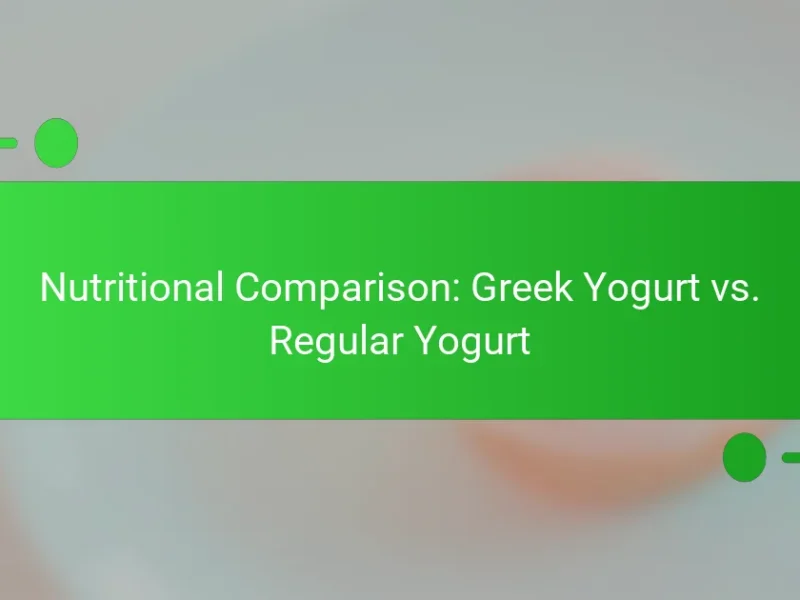Greek yogurt is a thick, creamy dairy product known for its high protein content and versatility in cooking. It serves as a healthier substitute for sour cream, mayonnaise, and cream, enhancing both savory and sweet dishes. The article outlines various uses of Greek yogurt, including its role in salad dressings, marinades, baked goods, smoothies, and dips. It highlights the benefits of incorporating Greek yogurt into recipes, such as adding moisture, creaminess, and nutritional value while reducing fat content. Additionally, the article emphasizes Greek yogurt’s contributions to flavor enhancement and its suitability for a range of culinary applications.

What is Greek Yogurt and Why is it Considered a Versatile Cooking Ingredient?
Greek yogurt is a thick, creamy dairy product made by straining regular yogurt to remove whey. This process results in a higher protein content, typically around 10 grams per serving. Greek yogurt is considered a versatile cooking ingredient because it can be used in both savory and sweet dishes. It serves as a healthier substitute for sour cream, mayonnaise, and cream in recipes. Its tangy flavor enhances dressings, marinades, and dips. Additionally, Greek yogurt can be incorporated into baked goods for moisture without adding excess fat. It is also commonly used in smoothies and parfaits for added creaminess and nutritional value.
How is Greek Yogurt different from regular yogurt?
Greek yogurt is different from regular yogurt primarily due to its straining process. This process removes excess whey, resulting in a thicker texture. Greek yogurt typically contains more protein than regular yogurt. For example, a 6-ounce serving of Greek yogurt has about 15-20 grams of protein, compared to 9 grams in regular yogurt. Additionally, Greek yogurt has a lower sugar content because some lactose is removed during straining. The tangy flavor of Greek yogurt is also more pronounced than that of regular yogurt. These differences make Greek yogurt a popular choice for cooking and baking.
What are the unique attributes of Greek Yogurt?
Greek yogurt is known for its distinct attributes. It has a thick and creamy texture due to the straining process that removes whey. This process also results in higher protein content, often containing double the protein of regular yogurt. Greek yogurt is lower in sugar compared to traditional yogurts. Additionally, it contains probiotics that support digestive health. Its versatility allows it to be used in both savory and sweet dishes. Greek yogurt can serve as a healthier substitute for sour cream or mayonnaise. Its tangy flavor enhances the taste of various recipes. These unique attributes make Greek yogurt a popular choice in cooking and baking.
Why does the straining process matter for cooking?
The straining process is essential in cooking to achieve desired texture and flavor. Straining removes excess liquid, resulting in a thicker consistency. For Greek yogurt, this process enhances its creaminess. It also concentrates flavors, making dishes more robust. Additionally, straining can reduce unwanted acidity in certain recipes. In many culinary applications, the right texture is crucial for presentation. For instance, strained yogurt can serve as a perfect base for sauces or dips. The straining process ultimately elevates the overall quality of the dish.
What nutritional benefits does Greek Yogurt provide?
Greek yogurt provides numerous nutritional benefits. It is high in protein, with approximately 10 grams per 100 grams serving. This protein content supports muscle growth and repair. Greek yogurt is also rich in probiotics, which promote gut health and improve digestion.
It contains essential nutrients like calcium, vital for bone health, with about 110 mg per 100 grams. Greek yogurt is lower in sugar compared to regular yogurt, making it a healthier option for those monitoring their sugar intake. Additionally, it is a good source of potassium, contributing to heart health by regulating blood pressure.
These benefits make Greek yogurt a nutritious addition to a balanced diet.
How does Greek Yogurt contribute to a balanced diet?
Greek yogurt contributes to a balanced diet by providing high protein content and essential nutrients. It typically contains around 10 grams of protein per 100 grams. This high protein content supports muscle health and satiety. Greek yogurt is also a good source of calcium, offering about 120 mg per serving. Calcium is crucial for bone health and metabolic functions. Additionally, it contains probiotics that promote gut health. These beneficial bacteria can enhance digestion and boost the immune system. Greek yogurt is lower in sugar compared to regular yogurt, making it a healthier choice. Its versatility allows it to be used in various dishes, enhancing nutritional value without compromising flavor.
What are the health advantages of using Greek Yogurt in recipes?
Greek yogurt offers several health advantages when used in recipes. It is high in protein, providing approximately 10 grams per serving. This protein content supports muscle health and aids in satiety. Greek yogurt also contains probiotics, which promote gut health by balancing intestinal flora. Additionally, it is lower in sugar compared to regular yogurt, making it a healthier choice for those monitoring sugar intake. Its calcium content contributes to bone health, with about 15% of the daily recommended intake per serving. Furthermore, Greek yogurt is versatile, allowing it to be used in both savory and sweet dishes, enhancing nutritional value without significant calorie addition.
In what ways can Greek Yogurt be used in cooking?
Greek yogurt can be used in cooking as a versatile ingredient for various dishes. It serves as a healthier substitute for sour cream in dips and dressings. Greek yogurt can also be incorporated into marinades, enhancing flavor and tenderness in meats. Additionally, it can be used to create creamy sauces without the added fat of heavy cream. In baking, Greek yogurt can replace oil or butter to reduce calories while maintaining moisture. It is also effective in smoothies, providing a creamy texture and protein boost. Furthermore, Greek yogurt can be added to soups to create a rich, creamy consistency. Its tangy flavor complements both sweet and savory dishes, making it a valuable ingredient in many recipes.
How can Greek Yogurt substitute for other ingredients?
Greek yogurt can substitute for various ingredients in cooking and baking. It serves as a healthier alternative to sour cream, mayonnaise, and heavy cream. Greek yogurt adds creaminess while reducing fat content. It can also replace buttermilk in recipes, providing a similar tangy flavor. When used in baking, it can substitute for eggs, adding moisture and protein. Additionally, Greek yogurt can be blended into smoothies as a replacement for ice cream. Its high protein content enhances the nutritional value of dishes. Many chefs use Greek yogurt to create lighter dressings and dips.
What are some common recipes that incorporate Greek Yogurt?
Common recipes that incorporate Greek yogurt include tzatziki sauce, smoothies, and salad dressings. Tzatziki combines Greek yogurt with cucumber, garlic, and herbs. Smoothies often blend Greek yogurt with fruits for creaminess. Salad dressings can mix Greek yogurt with lemon juice and herbs for a healthier option. Additionally, Greek yogurt is used in marinades for meats. It adds moisture and flavor to baked goods like cakes and muffins. Greek yogurt can also be a base for dips, mixing with spices and vegetables. These recipes highlight Greek yogurt’s versatility in various cuisines.

How can you effectively incorporate Greek Yogurt into your cooking?
Greek yogurt can be effectively incorporated into your cooking by using it as a substitute for sour cream, mayonnaise, or cream in various recipes. It adds creaminess and tanginess without excessive fat. For example, use Greek yogurt in salad dressings to enhance flavor and texture. It can also be mixed into sauces for added richness. Additionally, Greek yogurt works well in baking as a moisture enhancer in muffins or cakes. It can be used in smoothies for a protein boost. Furthermore, it serves as a base for dips, paired with herbs and spices. These methods leverage Greek yogurt’s versatility in both savory and sweet dishes.
What tips can enhance the use of Greek Yogurt in recipes?
Use Greek yogurt as a substitute for sour cream or mayonnaise in recipes. This enhances creaminess while reducing fat content. Incorporate Greek yogurt in marinades for meats to tenderize and add flavor. Mix Greek yogurt into smoothies for added protein and a creamy texture. Use it in baking to keep cakes moist and add nutritional value. Greek yogurt can also be used to thicken soups and sauces without adding extra calories. Adding herbs and spices to Greek yogurt creates a flavorful dip or dressing. Finally, layer Greek yogurt with fruits and granola for a nutritious parfait.
How should you store Greek Yogurt for optimal freshness?
Store Greek yogurt in the refrigerator at a temperature below 40°F (4°C) for optimal freshness. Ensure the container is tightly sealed to prevent exposure to air. This minimizes the risk of spoilage and contamination. Use the yogurt within the expiration date for best quality. If opened, consume it within 5 to 7 days for optimal taste and texture. Avoid leaving it out at room temperature for more than 2 hours to maintain its freshness.
What are some common mistakes to avoid when cooking with Greek Yogurt?
Common mistakes to avoid when cooking with Greek yogurt include using it at high temperatures. Heating Greek yogurt can cause it to curdle. Another mistake is substituting it for sour cream without adjusting the recipe. Greek yogurt has a thicker consistency and tangier flavor. Additionally, not accounting for its protein content can lead to unbalanced dishes. Overmixing Greek yogurt in recipes can also result in a grainy texture. Finally, using flavored Greek yogurt in savory dishes may impart unwanted sweetness.
What are some creative ways to flavor Greek Yogurt for cooking?
Mixing Greek yogurt with honey creates a sweet and creamy base. Adding fresh herbs like dill or basil gives a savory twist. Incorporating spices such as cumin or paprika enhances flavor depth. Blending in fruit purees, like mango or berry, adds natural sweetness. Using citrus zest, such as lemon or lime, brightens the taste profile. Stirring in nut butters provides richness and a nutty flavor. Adding garlic and lemon juice creates a tangy dip for vegetables. Each method transforms Greek yogurt into a versatile ingredient for various dishes.
How can herbs and spices enhance Greek Yogurt dishes?
Herbs and spices enhance Greek yogurt dishes by adding flavor, aroma, and nutritional benefits. Fresh herbs like dill and mint provide a refreshing taste. Spices such as cumin and paprika introduce warmth and complexity. This combination can transform a simple yogurt dish into a gourmet experience. For instance, a sprinkle of garlic powder can elevate the dip’s flavor profile. Studies show that herbs and spices can also boost antioxidant levels in meals. Incorporating them into Greek yogurt dishes can contribute to overall health benefits.
What sweet ingredients pair well with Greek Yogurt?
Honey pairs well with Greek yogurt. It adds natural sweetness and enhances flavor. Maple syrup is another excellent choice. It provides a rich, distinct sweetness. Fresh fruits like berries, bananas, and peaches also complement Greek yogurt well. They add freshness and nutrition. Dried fruits, such as raisins and apricots, offer chewy texture and sweetness. Granola can be mixed in for added crunch and sweetness. Nut butters, like almond or peanut butter, create a creamy, sweet combination. These ingredients not only taste good but also boost the nutritional profile of Greek yogurt.

What are the best practices for using Greek Yogurt in various types of dishes?
Greek yogurt is a versatile ingredient that enhances various dishes. It can be used as a substitute for sour cream in dips and dressings. This substitution reduces fat while maintaining creaminess. In baking, Greek yogurt can replace oil or butter, adding moisture and protein. It is effective in marinades, tenderizing meats and infusing flavor. Greek yogurt works well in smoothies, providing a creamy texture and protein boost. When making sauces, it can be used to create a rich base without heavy cream. For breakfast, it can be combined with fruits and granola for a nutritious meal. The high protein content of Greek yogurt supports muscle repair and satiety.
How can Greek Yogurt be used in savory dishes?
Greek yogurt can be used in savory dishes as a creamy base, a tangy dressing, or a substitute for higher-fat ingredients. It adds richness to sauces and dips. For example, it can be mixed with herbs and spices to create a flavorful dip for vegetables. Greek yogurt can also be used in marinades to tenderize meat. Its acidity helps to enhance the flavor of grilled or roasted dishes. Additionally, it can serve as a healthier alternative to sour cream in recipes. This versatility allows Greek yogurt to be incorporated into various culinary applications.
What are some examples of savory dishes that benefit from Greek Yogurt?
Greek yogurt enhances various savory dishes. It can be used in salad dressings for a creamy texture. Greek yogurt serves as a base for sauces, adding richness. It is often incorporated into marinades for meats, providing tenderness. Greek yogurt can be mixed into soups for added creaminess without excess fat. It is also used in dips, such as tzatziki, to add flavor and creaminess. Additionally, Greek yogurt can be a topping for baked dishes, enhancing flavor profiles. These applications showcase Greek yogurt’s versatility in savory cooking.
How does Greek Yogurt enhance the texture of these dishes?
Greek yogurt enhances the texture of dishes by adding creaminess and thickness. Its high protein content contributes to a rich mouthfeel. This makes it ideal for sauces, dips, and dressings. Greek yogurt can also replace heavier ingredients like sour cream or mayonnaise. It provides moisture without excessive fat. Additionally, it can create a smooth consistency in baked goods. The acidity of Greek yogurt can tenderize ingredients, improving overall texture. These qualities make it a versatile ingredient in various culinary applications.
How can Greek Yogurt be utilized in desserts?
Greek yogurt can be utilized in desserts as a healthier alternative to traditional ingredients. It can replace sour cream or heavy cream in recipes. This substitution reduces fat while maintaining creaminess. Greek yogurt also works well in parfaits, layered with fruits and granola. It can be whipped with sweeteners for a light frosting or dip. Additionally, it serves as a base for cheesecake, providing a tangy flavor. Recipes often include Greek yogurt in smoothies for added protein. Its versatility allows for incorporation into various dessert types while enhancing nutritional value.
What are some popular dessert recipes featuring Greek Yogurt?
Popular dessert recipes featuring Greek yogurt include Greek yogurt parfaits, Greek yogurt cheesecake, and Greek yogurt mousse. Greek yogurt parfaits combine layers of yogurt, fruits, and granola. This recipe is nutritious and customizable. Greek yogurt cheesecake uses yogurt instead of cream cheese for a lighter option. This dessert maintains a creamy texture while reducing calories. Greek yogurt mousse features whipped Greek yogurt mixed with chocolate or fruit puree. This recipe is airy and indulgent yet healthy. These desserts showcase Greek yogurt’s versatility and health benefits.
How does Greek Yogurt improve the nutritional profile of desserts?
Greek yogurt enhances the nutritional profile of desserts by increasing protein content and reducing fat. It contains approximately 10 grams of protein per serving, which supports muscle health and satiety. Greek yogurt also has lower fat content compared to traditional cream or sour cream, making desserts lighter. Additionally, it provides probiotics that promote gut health. The calcium in Greek yogurt supports bone strength and overall health. Substituting Greek yogurt for higher-calorie ingredients can lower overall calorie intake while maintaining creaminess. This versatility allows for healthier dessert options without sacrificing taste or texture.
What practical tips should you follow when cooking with Greek Yogurt?
Use Greek yogurt as a substitute for sour cream and mayonnaise in recipes. This swap reduces calories and adds protein. Incorporate Greek yogurt into marinades for tenderizing meat. The acidity in yogurt helps break down proteins, enhancing flavor. Use it in baking to replace oil or butter for moisture. This substitution can lower fat content while maintaining texture. When using Greek yogurt in dressings, mix it with herbs and spices for added flavor. This creates a healthier alternative to store-bought dressings. Avoid cooking Greek yogurt at high temperatures to prevent curdling. Instead, add it to dishes at the end of cooking. These tips enhance dishes while maximizing the health benefits of Greek yogurt.
Greek yogurt is a thick, creamy dairy product known for its high protein content and versatility in cooking. This article explores the unique attributes of Greek yogurt, including its use as a healthier substitute for sour cream and mayonnaise, and its incorporation into both savory and sweet dishes. Key nutritional benefits, such as probiotics and lower sugar content, are highlighted, along with practical tips for effective use in recipes. Additionally, the article provides insights on common mistakes to avoid and creative ways to flavor Greek yogurt, making it a valuable ingredient in various culinary applications.


